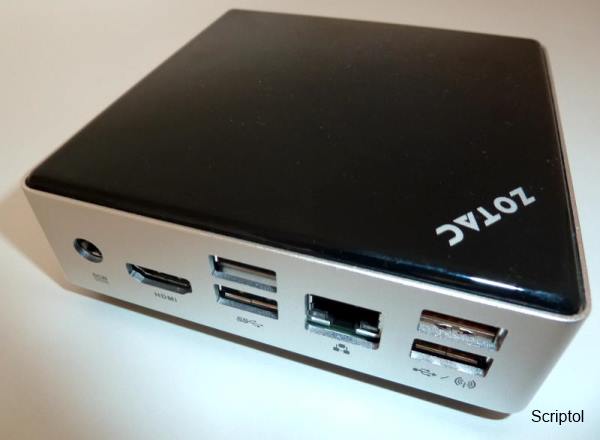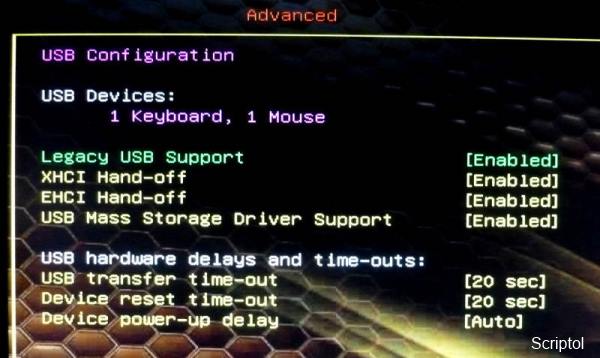Zotax Zbox, an experiment
Can we in 2013 (or 2014) use a nano computer such as the Intel's NUC or Zotac's Zbox as a desktop? To test this, I have acquired one of these devices to see if manufacturers have an answer to the question : "Is a tablet the desktop of tomorrow?". Why manufacturers do not they miniaturize the desktop ?
The model tested here is the AD13 which requires a SDD drive. There is a model with a hard drive, , the AD12, that is slightly larger but has the same basic features. Furthermore, some models come with memory and hard drive installed, and the other not. It is generally cheaper to buy these accessories separately and install them yourself.

The OS of my experience are Linux Mint and Windows 7. Installing XBMC was not a problem. This is probably the case with any other software, the choice depends on the use of the PC. But since the computer is supplied with a remote infra-red (it works immediately with Linux Mint and XBMC), it is often used for presentations or watching videos.
A test with different software such as LibreOffice, Gimp, shows that there is no difference in performance with the same software under Windows. The same is true in accessing Internet, so the nano PC (with a screen) could be an alternative to a Chromebook too.
Performances under Windows, especially for graphics are good for an office computer with a high DD data transfer rates thanks to the SSD. The memory speed is that of DDR2, not the DDR3 actually installed. It seems to be handled as a DDR2.

Performances of Zotac Zbox AD 13 or AD 12
Making USB 3.0 to work
The biggest disappointment with the Zotac is that the two USB 3.0 ports do not work with USB 3.0 external drives or keys, they only work with USB 2.0 units. Worse, the computer does not start at all if a 3.0 unit is connected.
It is assumed that the handling of USB 3.0 is left to the care of the operating system or drivers for Windows on the accompanying CD .
To try to solve this problem, I modified the setup of UEFI, the computer configuration.
You can access the UEFI by pressing the DEL key at the start of the computer.
The UEFI normally has an advantage over its predecessor, the BIOS, that it offers a nice graphical interface, which is not present on the Zotac! The options are not clear and only few of them are described in the manual : how to remove the green circle or how to use the USB port for power. Nothing about USB 3.0.
After some testing, and search on the Web, I have found how to enable USB 3 in the firmware : I set EHCI Hand-off to enabled instead of disabled, then USB 3 becomes accessible and USB 3 devices are automatically recognized by the system when they are connected!
To know what is this acronym, here is what says the Intel documentation:
- EHCI : Enhanced Host Controler Interface. To manage USB 2.0 by the firmware when the OS does not recognize it.
- XHCI : Extended Host Controller Interface. For USB 3.0 when the OS does not recognize it.
So what we can conclude is that, at least on this device, the XHCI which is what we are concerned only works if the EHCI is enabled too.

One problem still remains: the unit should not be connected at startup, it hangs the system. This prevents of course to boot the system from a USB 3.0 drive which would be much faster than USB 2.0.
My hypothesis is that the drivers are not implemented in the UEFI of Zotac and therefore it call a null process.
I saw in the Zotac forum that the problem on the AD12 was resolved after updating the BIOS, so still waiting for the update of UEFI !
However, you can still boot - when you have not installed an internal SSD drive - from a USB 2.0 or eSATA hard drive.
Conclusion
The Zotac has strengths over competitors: it is elegant and it has an impressive number of connectors considering its size. The weak point is the firmware that contains bugs for each unit of the brand and whose forums have numerous echos. When I tried to find an update to download on the site I was forwarded to another site that was not updated for ages.
Before purchasing a model of the brand I advise to check the availability of online drivers, documentation and update of firmware on the site. Another option would be to wait for a more modern product in the NUC Intel series, with more connectors (such as the NUC D54250WYK).
In terms of performance, these computers have nothing to envy to low-end desktops and portables, and are sufficient for office work, watching videos, making presentations, connecting to the Web. The graphics capabilities are too weak for 3D games with this integrated GPU, but it will be different in the future with the new models using the Intel HD 5000 GPU or AMD's Kaveri APU. The gradual disappearance of large desktops will begin.

